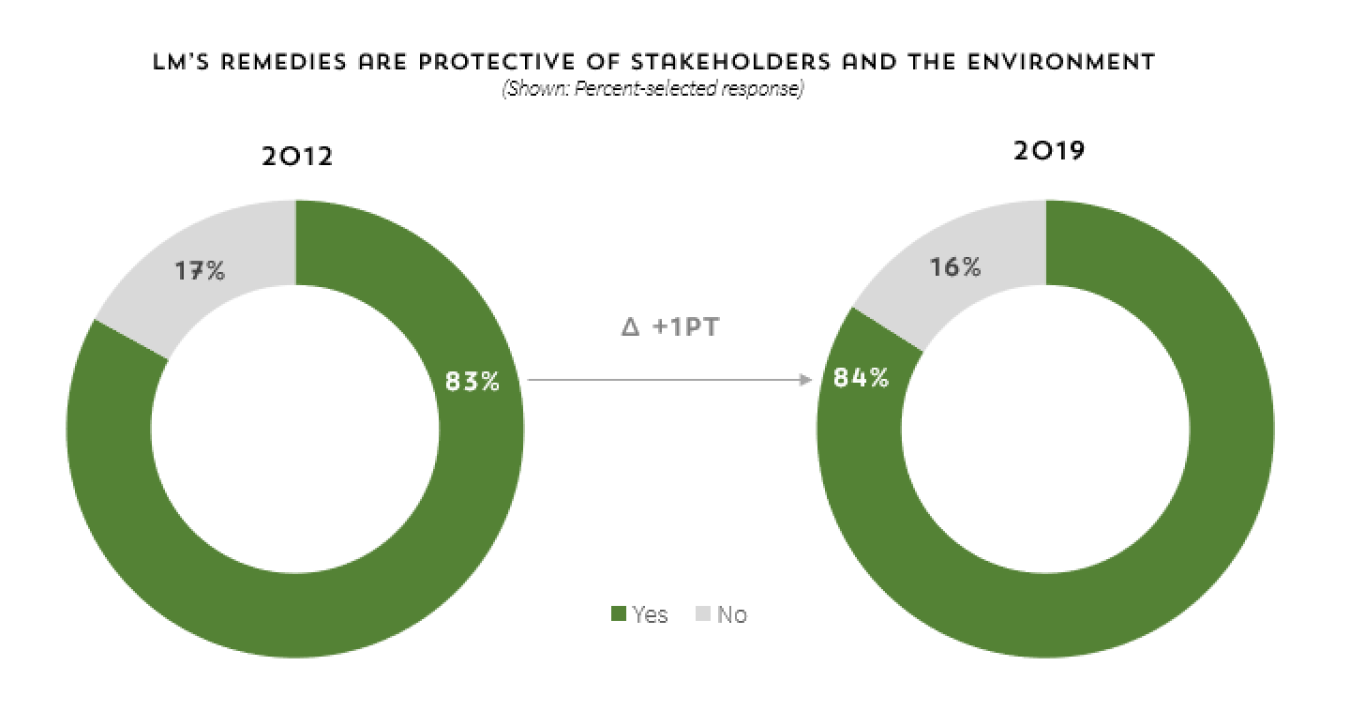LM is pleased to share the results of the 2019 Stakeholder Satisfaction Survey.
December 17, 2019LM is pleased to share the results of the 2019 Stakeholder Satisfaction Survey. The feedback collected is invaluable in helping LM staff understand how to expand our outreach and engagement efforts to communicate most effectively with stakeholders like you. Below is an overview of the key survey findings. To learn more about the study, click here to download a full version of the report.
Overall Stakeholder Satisfaction
First, the survey assessed satisfaction with LM’s performance and communications:
- Stakeholder satisfaction with LM’s performance remains high: 84% of stakeholders agreed that LM’s remedies are protecting people and the environment, compared to 83% in 2012 (see Figure 1).
Additionally, stakeholders exhibited moderate satisfaction with LM’s communications: 56% rating LM’s communications as either “good” or “excellent.” However, these positive ratings have declined significantly from 2012 when 66% rated LM’s communications as “good or “excellent” (see Figure 2).
This decrease is primarily driven by an overall dip in stakeholder use of LM communications: Reported usage has dropped across all LM channels, except social media, since 2012 — especially use of the LM website.

Figure 1: Change in stakeholder satisfaction with LM's performance over time.
Figure 2: Change in LM Communications Rating over time.
Opportunities to Improve Communications
Next, the survey explored opportunities for LM to improve its communication moving forward:
- Stakeholders identified LM’s greatest communications challenge as a lack of community engagement. The survey results made it obvious there is a strong appetite for getting more information about LM, especially from the LM website; through in-person, public, or community meetings; and from local news outlets (see Figure 3).
- To address this feedback, LM plans to continue its community engagement efforts and increase proactive communications outreach. Particularly, LM will expand communications on its website and social media proprieties.
Figure 3: Additional desired stakeholder communication channels.
Most Important Communication Topics
Finally, LM asked for feedback on language used to describe the missions, roles, and the various elements of work done at our sites:
- Stakeholders unanimously understand LM’s mission to be long-term stewardship, and they primarily associate LM’s role with “America’s nuclear legacy.”
- The most important elements of LM’s work to communicate with stakeholders are those related to the environment and public health and safety — particularly how LM monitors the environmental impact of its legacy sites and prevents public exposure to hazardous waste.
- Stakeholders also feel it is important for LM to communicate about levels of radiation at some of its sites by explaining how radiation is naturally occurring, and contextualizing LM site radiation levels compared to exposure from everyday experiences.
- LM plans to incorporate this feedback by refining the language used to describe our mission, roles, and work, as well as to prioritize what we communicate with stakeholders.
Survey Methodology: LM conducted an online survey of its stakeholders. All stakeholders in LM’s stakeholder database were invited to participate in the survey via email (or postcard for those stakeholders for whom LM did not have an email address). A total of 378 LM stakeholders participated in the survey from August 29 - October 20, 2019, with representation across 92 LM sites. The margin of error for the survey was ± 5.0%.

